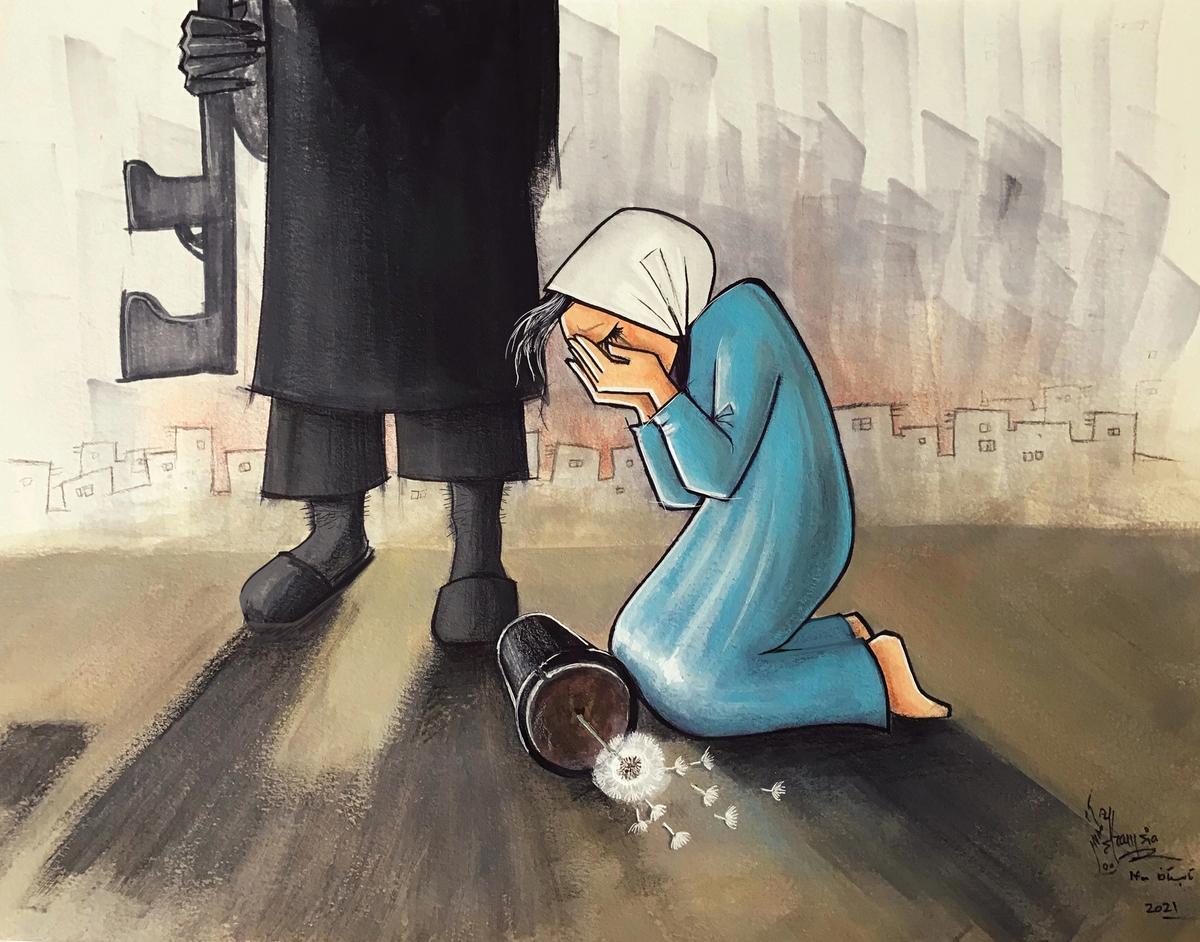This article is part of an ongoing series "Dispatches from Afghanistan" profiling Afghan artists and their experiences since the rise of the Taliban. Find all of the profiles so far here.
It was difficult to hear Mina clearly on the phone through her sobs as she described the pain, fear, betrayal and uncertainty she and her fellow Afghan artists and cultural workers have been experiencing since the Taliban takeover of their country.
“I can’t stop crying. Everything is destroyed,” says Mina, an artist, curator and cultural activist, from her hiding place in Kabul.
Having spent their careers fighting against extremist ideologies and for social justice, armed only with their art often in unimaginable conditions, they are frightened of what the Taliban may do to them if they are identified. They have taken the precautions of moving homes, often more than once, hiding or destroying their work and erasing their social media accounts.
“The blow that our community has suffered has not been endured by any other group. The Taliban are being pressured on many issues like women’s rights and journalists’ safety, but there are no discussions about the rights and safety of artists. We can’t raise our voice here, we are in hiding, that’s why we ask for the international art community to speak for us. Help us,” Mina says.
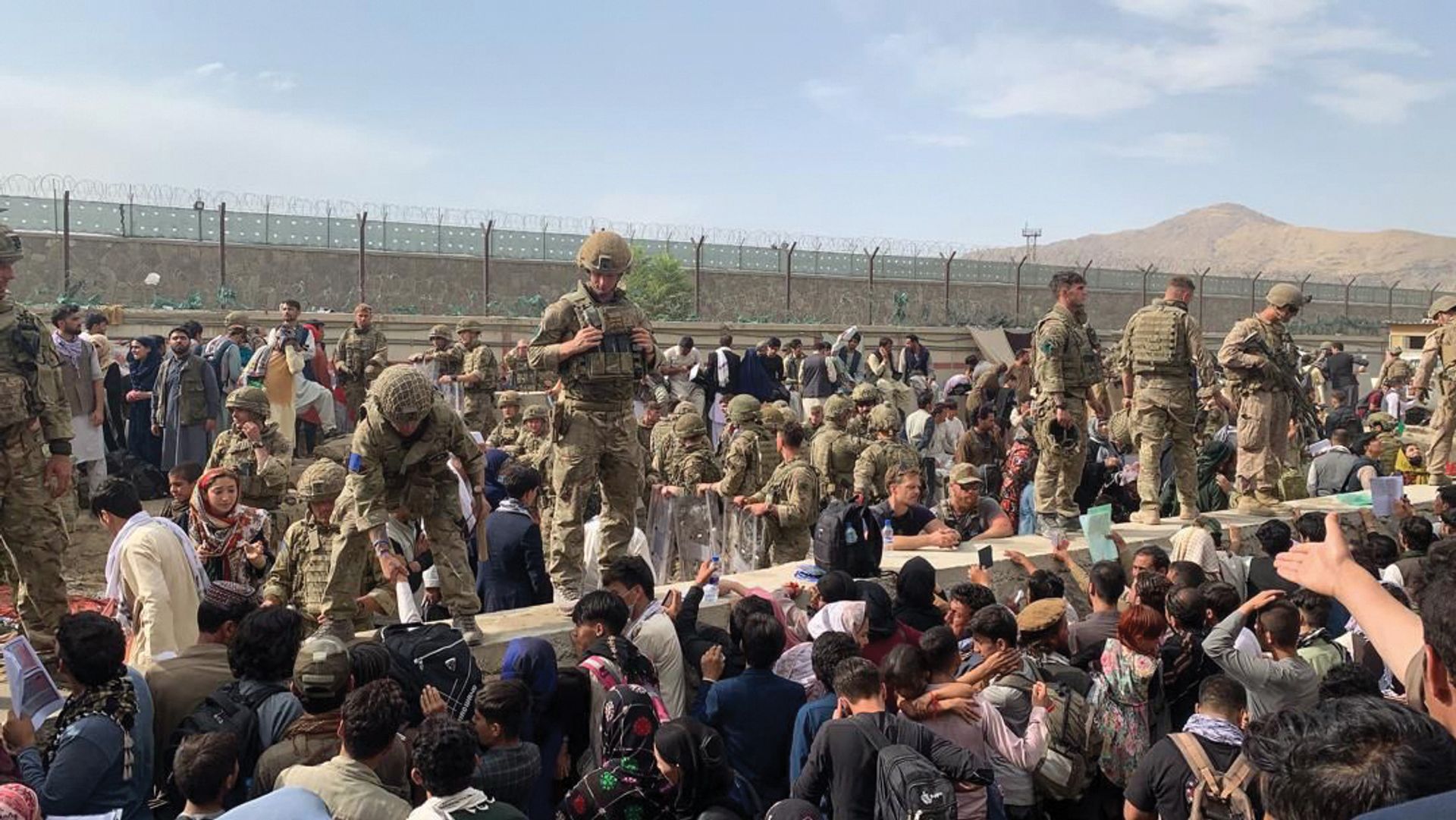
People crowded at Kabul airport’s Abbey Gate, hoping to get on an evacuation flight. Photo: Maria-Carmela Mini
The unexpected fall of Kabul on 15 August saw the US and its allies scramble to evacuate Afghans deemed to be at risk from the Taliban. The endangered were generally identified as those who assisted the military, government employees, journalists or people who collaborated with the Western embassies and organisations. Barring a few exceptions, artists and cultural workers were not prioritised for evacuation, least of all by the UK and the US.
Although the Taliban have promised change and amnesty to Afghans, their brutal revenge attacks have continued, and artists have not escaped unscathed. In late July Taliban militants shamelessly videoed their abuse of the popular comedian Nazar Mohammad, known as Khasha, in Kandahar; he was later found shot dead.
In early August, the poet and historian Abdullah Atefi was taken from his home in Uruzgan province’s Chora District and murdered, according to a statement by the province’s governor. In late August, the folk singer Fawad Andarabi was dragged from his house and shot dead in the Andarab Valley in the country’s north. The event occurred days after a Taliban spokesperson told the New York Times that the regime planned to ban music.
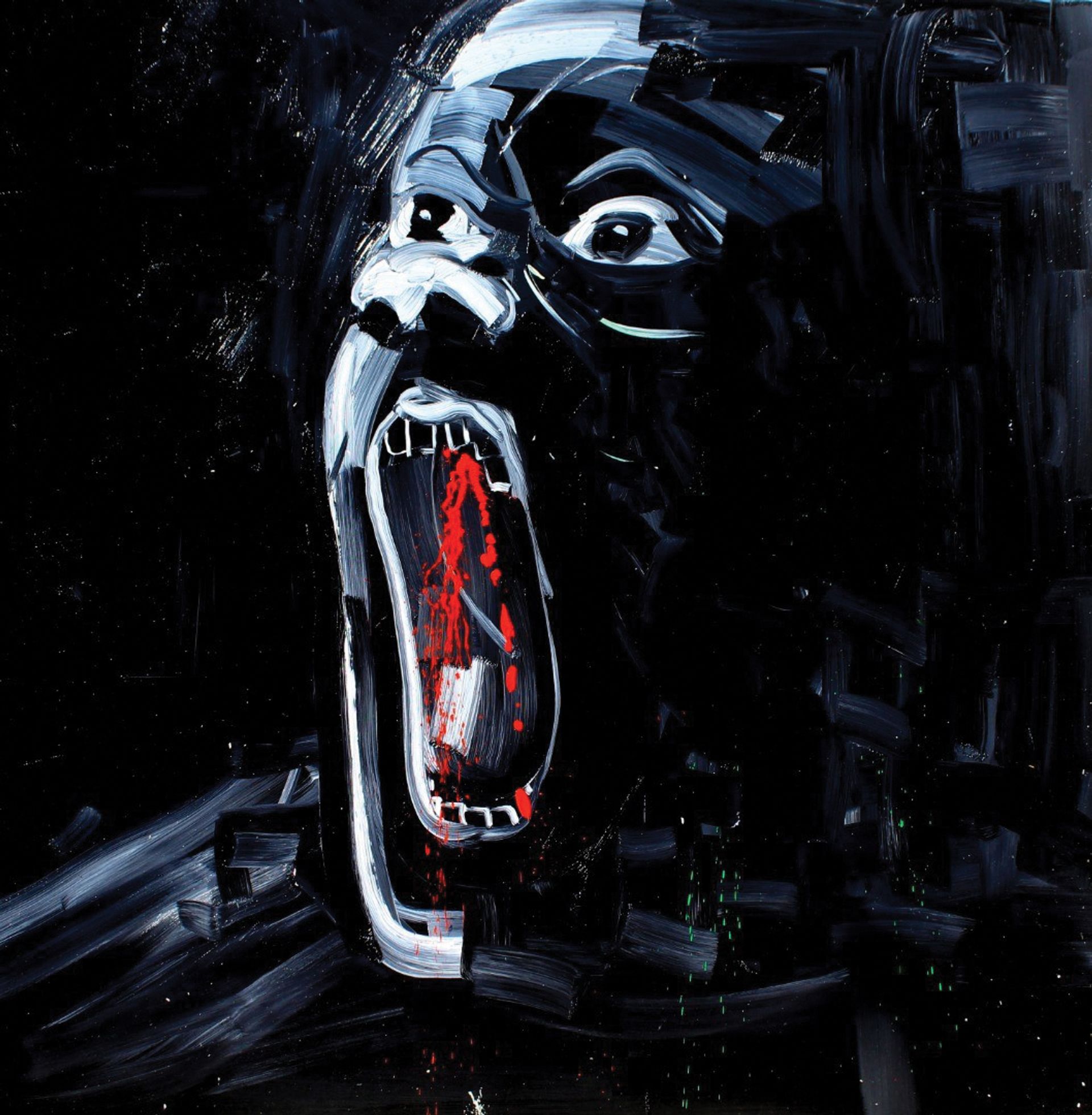
Muhib's Scream (2021) Courtesy of the artist
Behind closed doors the Taliban have signalled that they will review and provide artists with guidelines of what art will be allowed in due course. But the Afghan art community says they do not believe them. “They are untrustworthy. Their actions are different from what they say,” said Mina, a widely shared opinion among her peers.
What has left them feeling hurt and betrayed further, Afghans in the cultural scene say, is the general silence and lack of meaningful action from their fellow artists and the international community.
“We really did not expect that one day we would end up in this situation and the world would turn its back on us. That artists around the world would leave us. That the world’s politicians would leave us. To not be a story anywhere in the world and for no one to speak about our misery anywhere,” said a sombre Mansoor, co-owner of a cultural centre that has halted its activities.
Mansoor and several artists from their group have relocated their families and moved into an office together for the past few weeks. They hope staying and moving in a group of five or six will minimise their risk of being attacked.
Suleiman, a painter and an art teacher in his 20s, was distraught after seeing the walls on which he and his students had passionately painted murals now painted over by the new rulers.
“We wanted to make a difference, to expose more people to the arts. But it is all gone,” Suleiman says. With the banks still closed, his days, like many others, are spent in search of his next meal.
Sima, a talented player of the rubab (an Afghan stringed instrument) and music teacher, who had hoped to change her society’s negative outlook towards music and women in music, has not been able to leave her home for fear of being recognised and assaulted. “What will happen to everyone who made a living from music? What will they do now?”, asks Sima, who has not had an income for more than a month.
Although there have been high-profile open letters from the arts world demanding the US and the UK governments prioritise the safety of endangered Afghan artists and cultural workers, these have not resulted in any practical change.
One such letter was by a group called Arts for Afghanistan, which has now gained more than 1,000 signatures. Leeza Ahmady, who directs the US-based curatorial and educational platform Asia Contemporary Art Forum (ACAF) and is director of programmes at the Foundation for Spirituality and the Arts (FSA), was one of the main circulators of the letter.
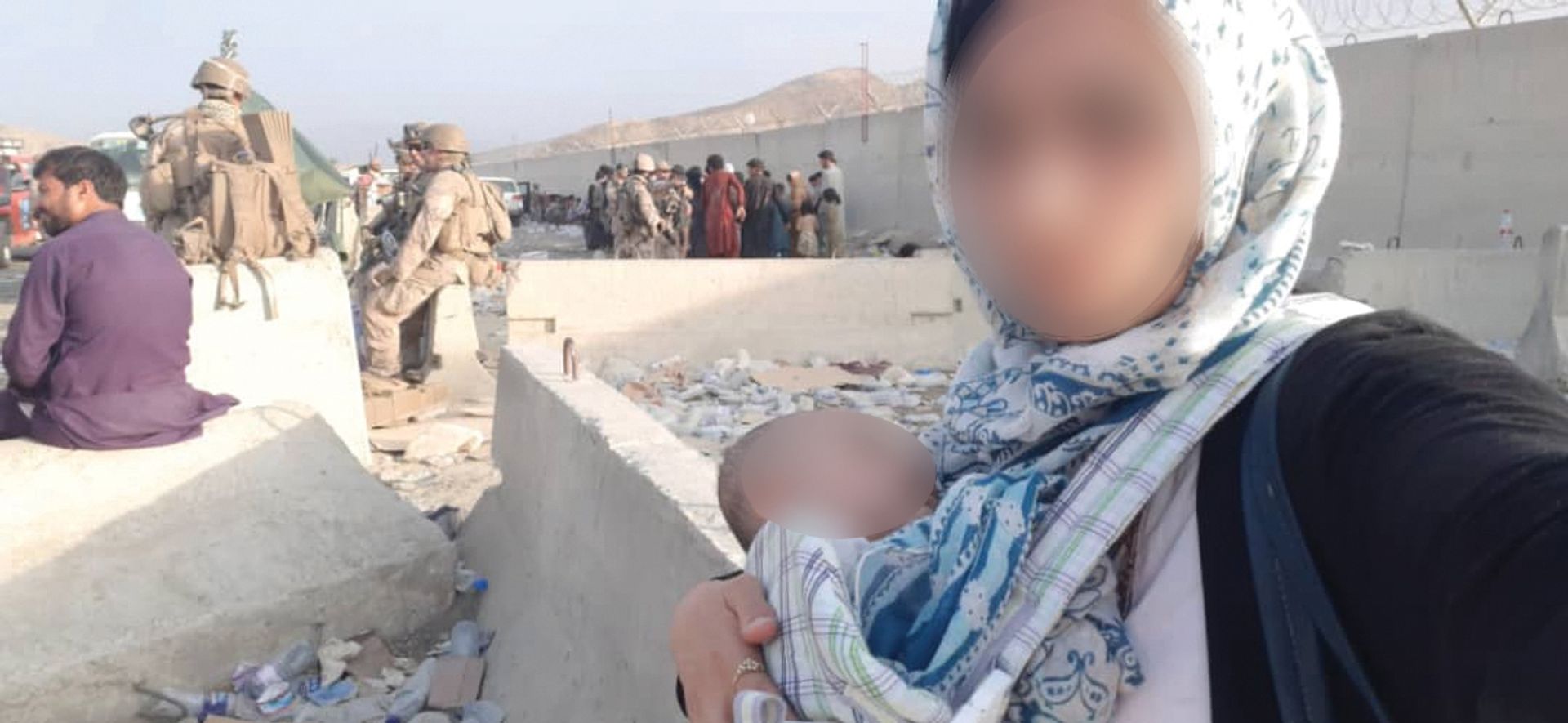
Mina’s baby almost suffocated in her attempt to get through the crowds gathered at the airport gate in Kabul. Her evacuation contact was unable to meet her due to security concerns. She was finally escorted out of the airport and left behind. She is still in Afghanistan. Photo: courtesy of the artist
The plea did not result in artists being evacuated. However, Ahmady says the publicity brought the art organisations’ valuable support to the cause.
“We know who they are, we can raise the money, we need help to remove the other impediments to get these artists to safety,” says Ahmady, who has compiled a list of 258 Afghan artists and cultural workers in danger.
Ahmady says the international arts community can act by exerting pressure on politicians, offering residencies, providing support letters for visas, creating university or other arts positions, and obtaining legal and financial support.
“The art world is a global community and the only reason it is functioning is because everyone contributes to its ecology. Perhaps any of these artists could be the next major contributor to the art discourse in one way or another. If we are talking about inclusivity, democracy and equity, then let’s actually show it by taking action,” Ahmady says.
Graham Sheffield, the former director of arts at the British Council and the current chair of Help Musicians UK, echoed Ahmady’s sentiments on the importance of saving the young generation of Afghan talent.
“Artists and cultural workers have been at the forefront of the battle for social advancement in Afghanistan, as much as the people who assisted the British forces and the government. They are now in danger for their lives and deserve to be supported. I am hardly surprised at the lack of sensitivity from the UK government in prioritising these individuals as endangered. They have largely ignored cultural workers here in the UK during a combination of Brexit and Covid—but at least they don’t actually kill them. Something has to change relative to our Afghan artist friends. We have a collective responsibility to help them—and swiftly,” Sheffield says.
The arts community in France has perhaps rallied around Afghan artists most effectively.
In July Maria-Carmela Mini, the director of Latitudes Contemporaines festival in Lille, was contacted by the visual artist Kudra Khademi to seek her help in removing artists from Afghanistan to keep them out of the Taliban’s reach.
Conscious they would not be able to help everyone, they made a list of the most vulnerable. The result was a list of 92 female Hazara artists from
the Bamiyan area who had historically been subjected to the worst of the Taliban’s wrath.
Mini and Khademi, with Joris Mathieu, the director of Lyon’s Théâtre Nouvelle Génération, would spend the next few weeks glued to their phones, frantically coordinating the pull out of the group with the French authorities in France and on the ground in Kabul. Despite several setbacks, the trio succeeded in getting 72 of the artists and their families to France.
Mini remains in regular contact with the remaining 20 artists who are in hiding in Kabul, supporting them financially and continuing her dialogue with the French authorities to evacuate them. She is adamant that they do not need to pressure the government: “They are doing a lot to help.” However, she is far too aware that there are many artists not on her list and still in the country.
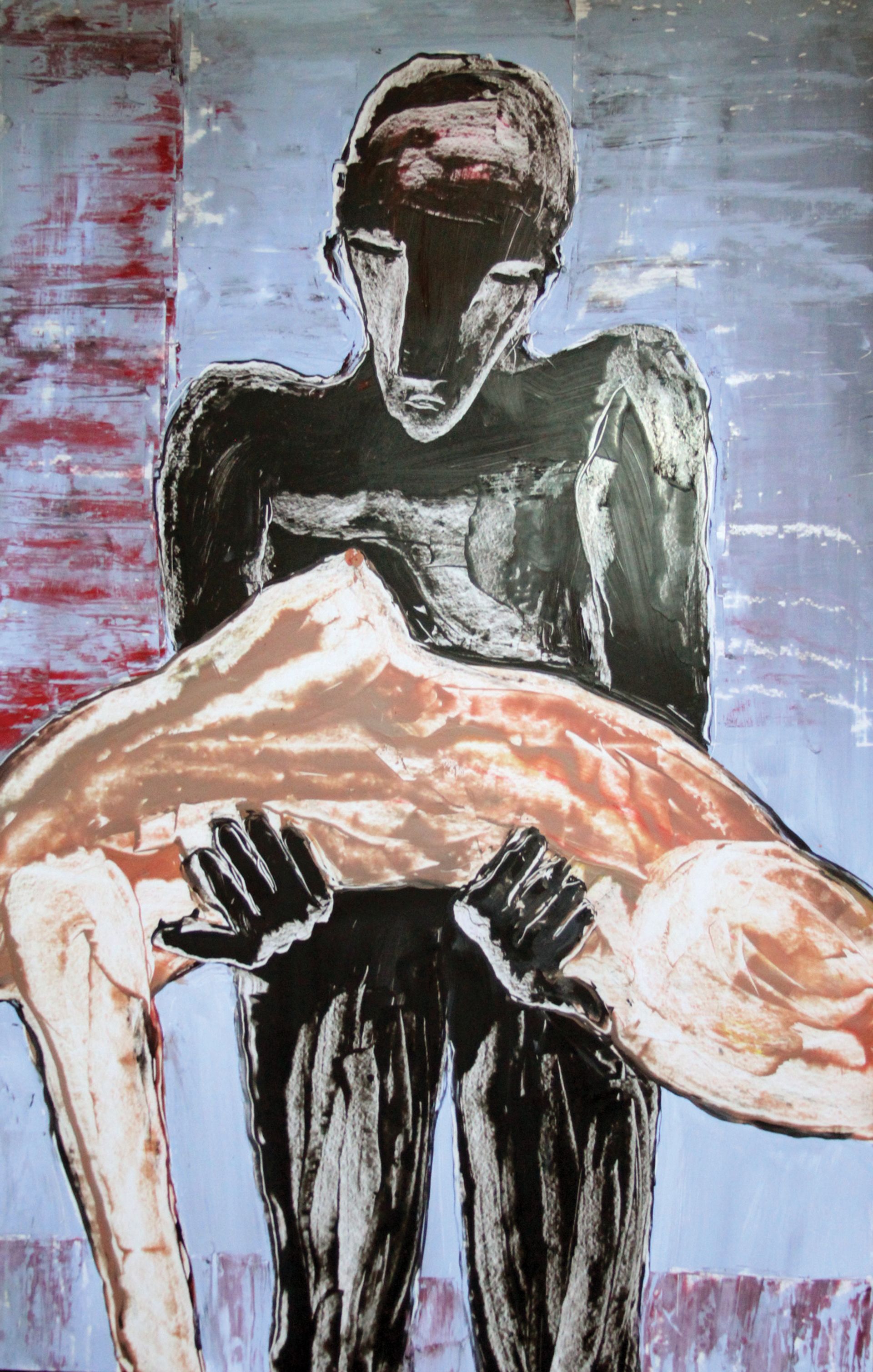
Untitled (2013) by Afghan artist Mohsen Hossaini, from a series called Melancholy. Hossaini says his work is inspired by three factors: immigration, the streets of Kabul and a bullet fired from a gun. © Mohsen Hossaini
“The international art community should do everything in their power to force politicians to get endangered artists out of Afghanistan. They are the future and heritage of Afghanistan and should be protected and cherished. And it is the humane thing to do. I am a small citizen in France and I did what I could but one person cannot save everyone,” Mini says.
As the internet connection on Mina’s end grows weaker, her voice cuts out several times during the online call. I offer to call her on the phone but she politely declines. “A call from a foreign number is dangerous, could raise suspicion,” she says, adding that she and her family cannot afford to be detected.
We end our call and Mina goes back to silently sitting in her shelter, watching whether outsiders will take any action to help change her grim, colourless future.
• Some names have been changed to protect people’s identities
This article is part of an ongoing series "Dispatches from Afghanistan" profiling Afghan artists and their experiences since the rise of the Taliban. Find all of the profiles so far here.


